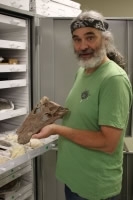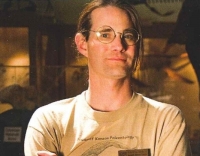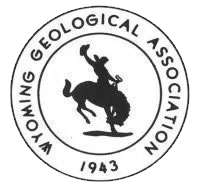Membership
Join or renew your WGA Membership
WGA Bookstore
Find WGA Geology Publications
Mud Log Library
6000+ Mud Logs Available!
Wyoming Geological Association

Casper’s Cretaceous Sea Fossils
J. P. Cavigelli, The Tate Geological Museum
So, you wanna see some cool fossils from right here in Casper? Well, let’s start with a housing development near Sagewood Elementary School. Early in my career at the Tate a local fellow brought us some unusual fossils he had found in a pile of rock removed from some future basements. This led the Tate to exploring the site and collecting over 250 fossils from here over several visits. The fossils are form the Cody Shale, which is known to produce fossil, primarily in concretions. Most of these fossils are in the shale itself, rather than in concretions. The fossils tend to be impressions with very little organic material left. But many are fossils of creatures we rarely see in the Cody Shale and other Western Interior Seaway deposits. Come to this presentation for a trip into the Cretaceous sea as it is seen right here in Casper.
Jean-Pierre Cavigelli
JP Cavigelli was born back east in the summertime, of Swiss immigrant parents (from the type Jurassic area). He is prep lab manager and field trip organizer and collections manager at that Tate Geological Museum at Casper College. As a biology major at the University of Chicago, JP became interested in paleontology, although way too late to get a degree in it. This led him to a summer spent in Wyoming (mostly in the Big Horn Basin) in 1983 doing field work in search of small Cretaceous mammal teeth with a University of Wyoming team. JP fell in love with Wyoming but left for a five year adventure in fun and poverty as a ski bum and whitewater rafting guide in Colorado and Australia. JP came back to Wyoming in 1990 to be part of a paleontology field crew at the UW again. He lived in Laramie working off and on in paleontology for 14 years, doing field work as well as a two year post as the Collections Manager for the UW's Dept. of Geology and Geophysics. He also was a fossil outfitter, running Western Paleo Safaris for six years. For the past 25 or so years, JP has been doing freelance fossil preparation in his personal prep lab. He has had the good fortune of having been invited to join international paleontological expeditions to Niger, Mongolia, Tanzania, Alaska and North Dakota. In his 19 years at the Tate Museum he has led collecting trips all over the state to collect small and large fossils from Dee the Mammoth and Lee Rex to microscopic mammal teeth and really old insects and ichthyosaurs. When he is not involved with fossils JP enjoys birdwatching, traveling, and hanging out with his supercalifragilisticexpialidocious wife (they were married on a dinosaur skeleton).
| Event Date | 12-06-2024 10:45 am |
| Event End Date | 12-06-2024 1:00 pm |
| Capacity | 50 |
| Individual Price | Members $20, Student Members $10, Non-Members $25 |
Topic: Liability is Forever: Risk Elements in the Implementation of Decommissioning and Well P&A
| Event Date | 12-13-2024 10:45 am |
| Event End Date | 12-13-2024 1:00 pm |
| Capacity | 40 |
| Individual Price | $20.00 |

Abstract
Casper Wyoming’s Standard Oil Refinery – A Resource Reborn
Robert A. (Bob) King
1551 Three Crowns Drive, Suite 301
Casper, Wyoming 82604
Standard Oil of Indiana’s oil refinery along the North Platte River in Casper operated from 1912 through 1991, and was the lifeblood of Casper’s economy for 80 years. First operated by Midwest Refining Company to process Salt Creek Field oil, by the early 1920s it had a capacity of 55,000 barrels per day and was the largest gasoline producing refinery in the world. Standard took ownership of the facility by the late 1920s and operated under the Amoco name in 1972.
In late 1991 Amoco announced it was closing the refinery due to projected costs to meet present and future regulatory requirements, its age and small size, marginal performance, and decreasing crude availability. Throughput had decreased to about 28,000 barrels per day. The closing caused consternation within the community, fearful the site would become an eyesore that would remain unused for the foreseeable future. A citizens group came together to work with Amoco, regulatory agencies overseeing environmental concerns, city and county officials, and the public to propose an expedited plan to return the sites to beneficial use in a timely manner.
Negotiations were undertaken to develop a collaborative process whereby Amoco, the Wyoming Department of Environmental Quality, the Environmental Protection Agency, state and local government, and the public worked together to reach protective, reasonable and timely decisions for the cleanup and reuse of the site. A reuse agreement was reached between Amoco, the City of Casper, and Natrona County, and the collaborative process was overseen by a city/county joint powers board. Wyoming’s Legislature passed a Brownfields Law allowing remediation based on restricted land use. Design standards and a corrective action plan were developed, and Amoco implemented a program to clean up the sites to remediate soil and water contamination from an estimated 30 million gallons of hydrocarbon by-products spilled during the refinery’s 80 years of operation.
The final reuse plan included a golf course, kayak course, river-park with picnic areas, bicycle and walking trails, business and industrial parks with utilities infrastructure, new roadways, and renovation of the refinery administrative building. No residential housing would be permitted, and Amoco would provide funding packages to the city/county for operation and maintenance, economic development, and building and facilities development both on and off-site. Amoco transferred most of its water rights to the city and county, and continued to own the lands occupied by the former refinery.
British Petroleum (BP), which acquired Amoco in 1999, built an oil/water separation facility, drilled over 500 groundwater recovery and monitor wells, built an 8,000' steel barrier wall along the North Platte River, and constructed a water treatment system integrated into part of the golf course whereby recovered hydrocarbons are separated through a series of filtering wetlands. Clean water is sent to Casper’s water treatment plant. 380,000 tons of concrete, 250 miles of piping, and 600,000 cubic yards of soil were removed. Waste material and contaminated soils were hauled to a Correction Action Management Unit (CAMU), clean soil was spread over the refinery site, and trees were planted to assist with phytoremediation.
Re-development of the former refinery site began in 2004 with the construction of the whitewater kayak course and golf course. The Wyoming Oil and Gas Conservation Commission relocated to the site, office buildings were constructed by private parties, and the refinery’s original administration building was enlarged into a business innovation center owned by the University of Wyoming. The North Tank Farm area became an industrial park with lands available for purchase by third parties.
Robert A. (Bob) King
Bob grew up in Denver, graduating from the Colorado School of Mines in 1972 with a degree in Chemical and Petroleum Refining Engineering. He began his career with Humble Oil (Exxon) in Oklahoma, with later assignments in Saudi Arabia and Texas. Bob moved to Wyoming in 1980 for Monsanto, and in 1982 went to Wold Oil where he worked for 23 years before starting his consulting business in 2006.
Bob has served as a Commissioner for the Wyoming Oil & Gas Conservation Commission and as the Commission’s Interim Supervisor. He currently chairs the Enhanced Oil Recovery Commission, is a 53-year member of the Society of Petroleum Engineers, and a 33-year member of the Wyoming Geologic Association. He has chaired the 1990 United Way Campaign, 2001 Amoco Reuse Agreement Joint Powers Board, Casper Planning and Zoning Commission from 2016-2020, and currently serves on Casper’s Historical Preservation Commission.
Bob enjoys researching local history and has written New York Times Best Sellers (?) about the history of Casper’s Petroleum Club, Wyoming’s railroads, and Wyoming’s oil refineries.
| Event Date | 01-10-2025 10:45 am |
| Event End Date | 01-10-2025 1:15 pm |
| Capacity | 66 |
| Individual Price | $20.00 |

Bio
Bringing more than two decades of engineering and project management experience, Joe leads the technical growth of Frontier Carbon Solutions. Prior to joining Frontier, Joe spent 7 years at Fleur de Lis Energy, ultimately serving as the Chief Operating Officer. At Fleur de Lis Energy, Joe was responsible for onboarding and integrating 5 major transactions and managing 100,000 boepd of production, including two CO2 enhanced oil recovery fields in Wyoming. He played a critical role in preparing multiple asset divestiture packages totaling $1.4 billion in successful sales. Joe’s prior experience includes technical roles with ConocoPhillips, Merit Energy Company and Nerd Gas Company. Joe earned his BS in Chemical Engineering at University of Wyoming and a PhD in Chemical Engineering at Colorado School of Mines. He is a registered Professional Engineer and an active volunteer in Wyoming youth sports.
Abstract: SWEETWATER CARBON STORAGE HUB PROJECT
Frontier is developing the Sweetwater Carbon Storage Hub (“SCS Hub”), one of North America’s first open source, multipurpose carbon storage hubs. The SCS Hub spans more than 100,000 acres in southwestern Wyoming and will provide a carbon management solution for key industrial emitters across the Mountain West. Additionally, Frontier has received 3 Class VI UIC Permits issued by the Wyoming Department of Environmental Quality for CO2 injection, the first of their kind in the state. When fully developed, the SCS Hub is expected to store over 350 million metric tons of CO2 in geologic reservoirs.
| Event Date | 01-24-2025 10:45 am |
| Event End Date | 01-24-2025 1:15 pm |
| Capacity | 66 |
| Individual Price | $20.00 |
| Event Date | 02-14-2025 10:45 am |
| Event End Date | 02-14-2025 1:15 pm |
| Capacity | 66 |
| Individual Price | $25.00 |
Software Symposium Roadshow
| Event Date | 02-21-2025 10:45 am |
| Event End Date | 02-21-2025 1:15 pm |
| Capacity | 66 |
| Individual Price | $25.00 |
| Event Date | 03-11-2025 |
| Event End Date | 03-11-2025 |
| Capacity | Unlimited |
| Individual Price | Free |
Abstract: Insightful Geomechanical Measurements for Converting Existing Hydrocarbon Reservoirs to Carbon Storage
| Event Date | 03-14-2025 10:45 am |
| Event End Date | 03-14-2025 1:15 pm |
| Capacity | 66 |
| Individual Price | $25.00 |

Bio: Russell J. Hawley is the Education Specialist at the Tate Geological Museum at Casper College in Wyoming, where he gives tours and produces artwork for museum displays. He also contributes a palæontology question and answer column to the museum newsletter. Russell has worked at the museum since 1997, and started digging up fossils in Wyoming in 1990. He illustrated Islands in the Cosmos: the Evolution of Life on Land by Palæontologist Dr. Dale Russell. His one-man art show, ‘A Thousand Unnamed Worlds’, was on display for two years at the Wyoming State Museum in Cheyenne.
| Event Date | 03-28-2025 11:15 am |
| Event End Date | 03-28-2025 1:15 pm |
| Capacity | 40 |
| Individual Price | $25.00 |
Find Out What's Happening at WGA
View current and archived issues of "Contact" the Wyoming Geological Association Newsletter.
WGA Sponsors
Thanks to all our valuable WGA Sponsors! Are you interested in advertising with WGA. Learn how.
Website Design by Waves Web Design.



